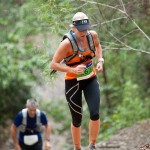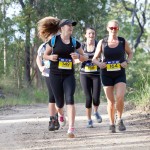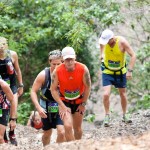Words by Britt Caling, APA titled Sports & Exercise Physio.
Why not do some Trail Running to complement your Road Running training?
 So you think Trail Running and Road Running are the same thing? Wrong! Trail running is the off-road equivalent to mountain biking compared to road riding, and Trail running is surprisingly different to on-road running. If you haven’t tried trail running, I recommend you have a go to understand that there are some fantastic benefits to running off-road that can complement your on-road training programs.
So you think Trail Running and Road Running are the same thing? Wrong! Trail running is the off-road equivalent to mountain biking compared to road riding, and Trail running is surprisingly different to on-road running. If you haven’t tried trail running, I recommend you have a go to understand that there are some fantastic benefits to running off-road that can complement your on-road training programs.
What are the main differences between trail and road running?
– Your stride will be slightly different and more variable off-road. Every step you take on a trail will be slightly different due to varying terrain so your tissues never experience exactly the same force two steps in a row. Additionally, the softer trail surfaces reduce the ground impact force compared to normal on-road running surfaces. This will help reduce the risk of sustaining an overuse injury. Overuse injuries (such as shin splints, ITB friction, Achilles injury and bone stress fractures) are commonly associated with the repetitive microtrauma caused by road running.
– When trail running you are required to lift your feet over obstacles (fallen branches, logs, rocks, roots and the occasional animal) so you need greater hip flexion and therefore better hip flexor and abdominal strength; you will develop greater foot and ankle stability; and you will tend to have a slightly shorter stride length in technical terrain
– Trail running usually involves hills so off-road is more about strength and co-ordination than pure technique and running economy
Tips for running off-road:
 – As a sports Physio, I recommend taping your ankles when starting out running on trails to minimise the risk of an ankle ligament sprain.
– As a sports Physio, I recommend taping your ankles when starting out running on trails to minimise the risk of an ankle ligament sprain.
– Use specific trail running shoes. These shoes have features that will help make your trail running easier: greater under-sole grip (usually more lugs and nodules) and a different rubber compound for better grip on slippery surfaces such as rocks and logs; some have a firmer plate in the sole so that sharp rocks don’t protrude through the shoe into your foot; and they often have a firmer arch and rearfoot/heel counter support to help keep your foot firmer on an unstable surface.
– Know where you are and/or where you are going: take a phone, a map or run with someone who knows where they are going. Take a gel or food if you plan a longer run just in case you get lost
– Get into the habit of taking water with you or puratabs to sterilise water from creeks. It’s unlikely you will come across a working tap in the middle of the bush!
– Run to time, not distance. Undulating terrain and varying underfoot conditions makes it difficult to run to pace, so don’t expect to run the same speed off road as you do with your road training.
 – Run light on ground contact but with a feeling of “firm” ankles and feet. The idea is that your ground contact time should be minimal. This ensures that your foot will be quickly on and then off any moving obstacles under your feet to reduce slipping.
– Run light on ground contact but with a feeling of “firm” ankles and feet. The idea is that your ground contact time should be minimal. This ensures that your foot will be quickly on and then off any moving obstacles under your feet to reduce slipping.
– Look ahead 2-4m in front so you choose the best line to run and sight where you place your feet.
– You may encounter obstacles when trail running that you would never see on road, like rickety bridges with panels missing, slippery boulders and snakes. Don’t be afraid to stop and walk at any time that you feel uncomfortable or hesitant. I call this trail running Occupational Health and Safety- better to be safe and sure than risk getting injured in a fall.
Finally but most importantly, don’t forget to appreciate your surrounds: no cars, beautiful scenery and peace and quiet make for a great experience

































